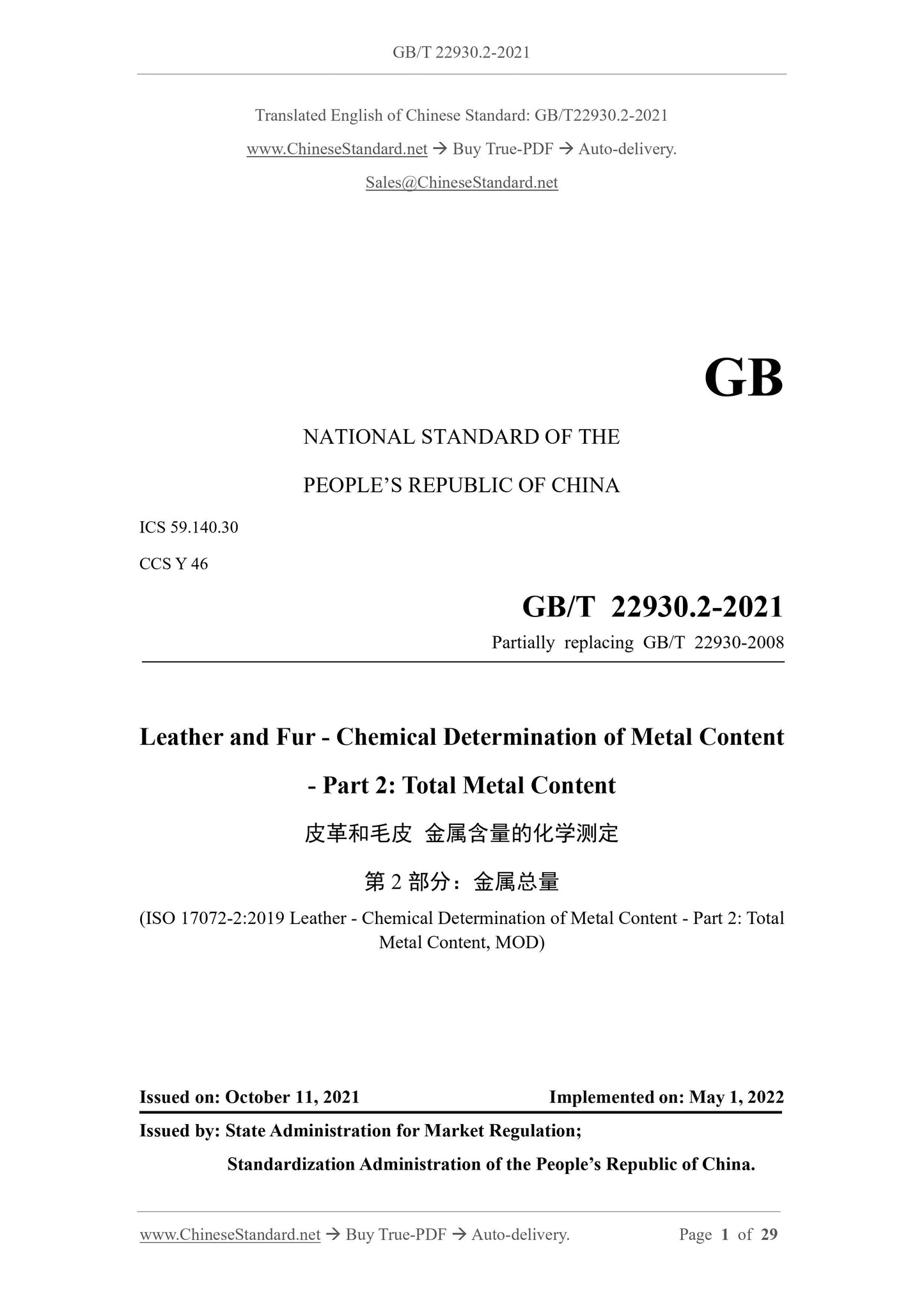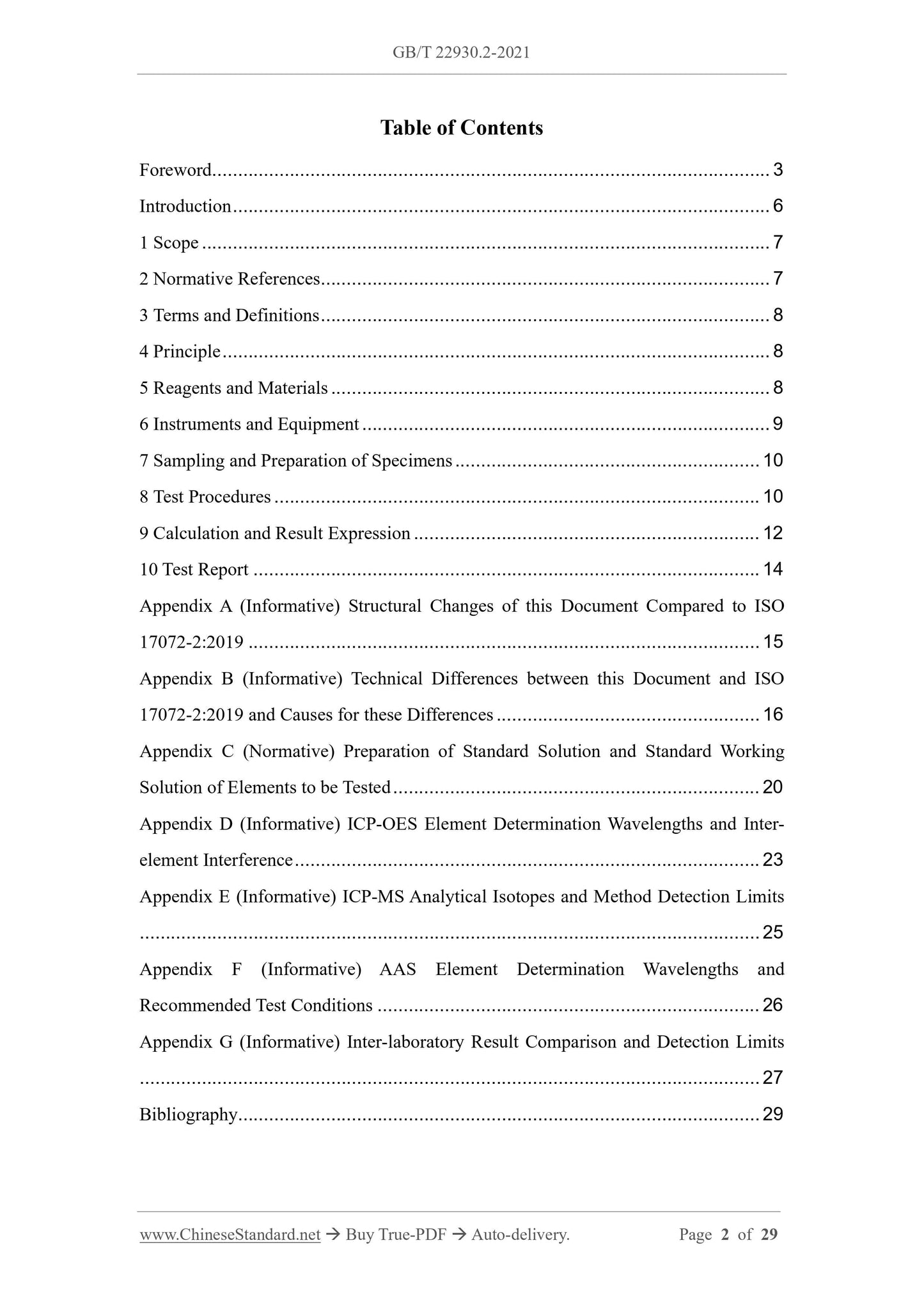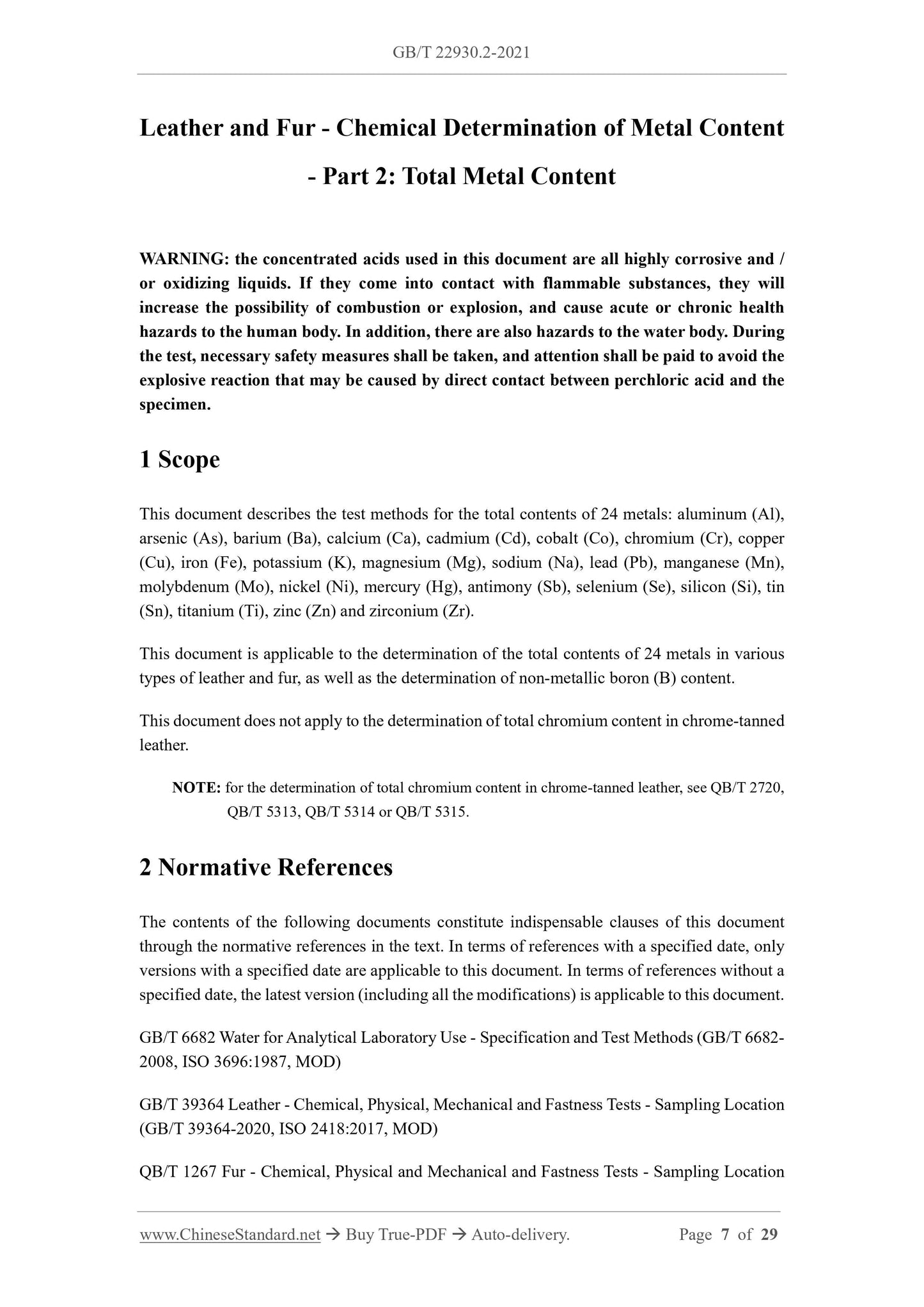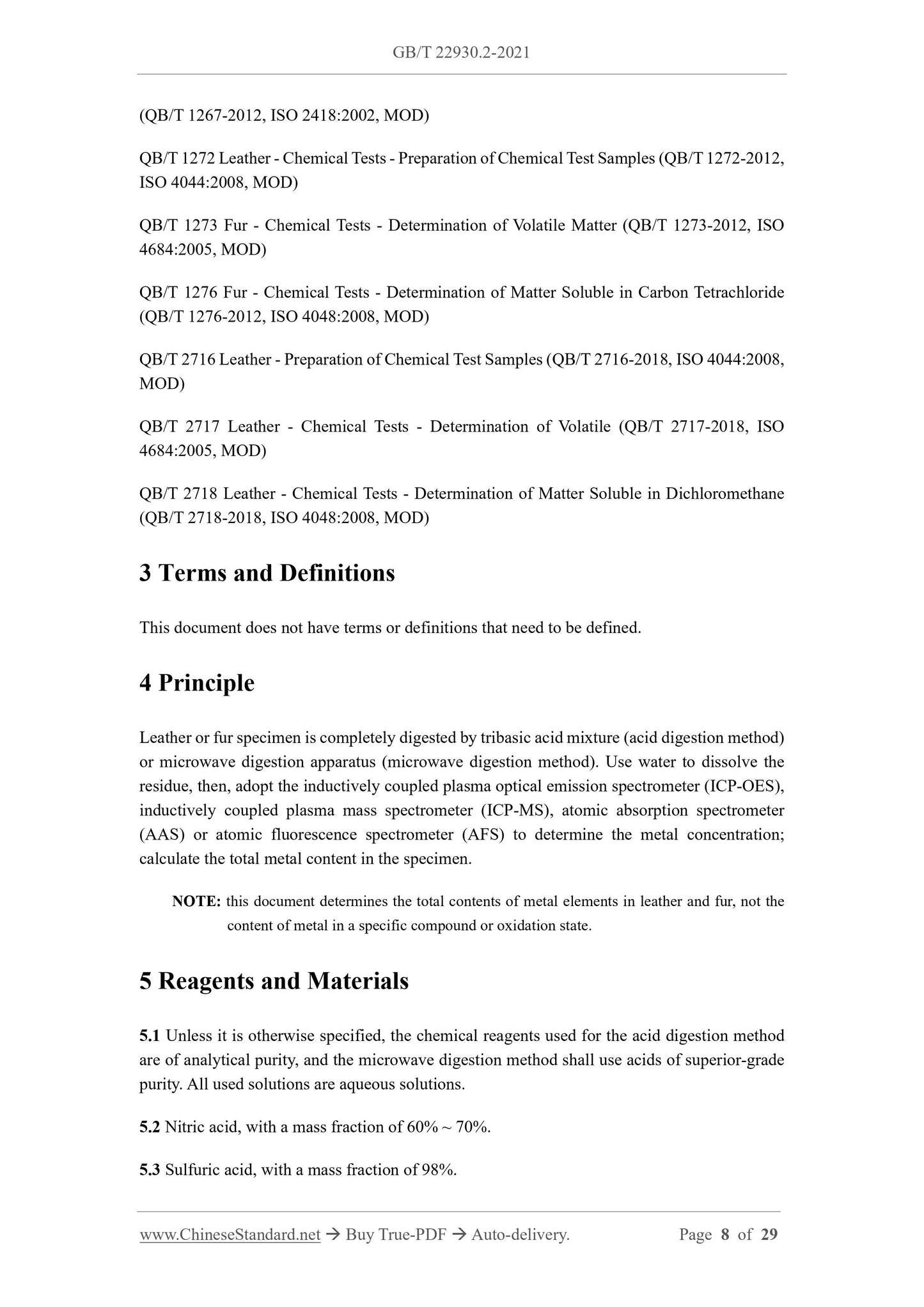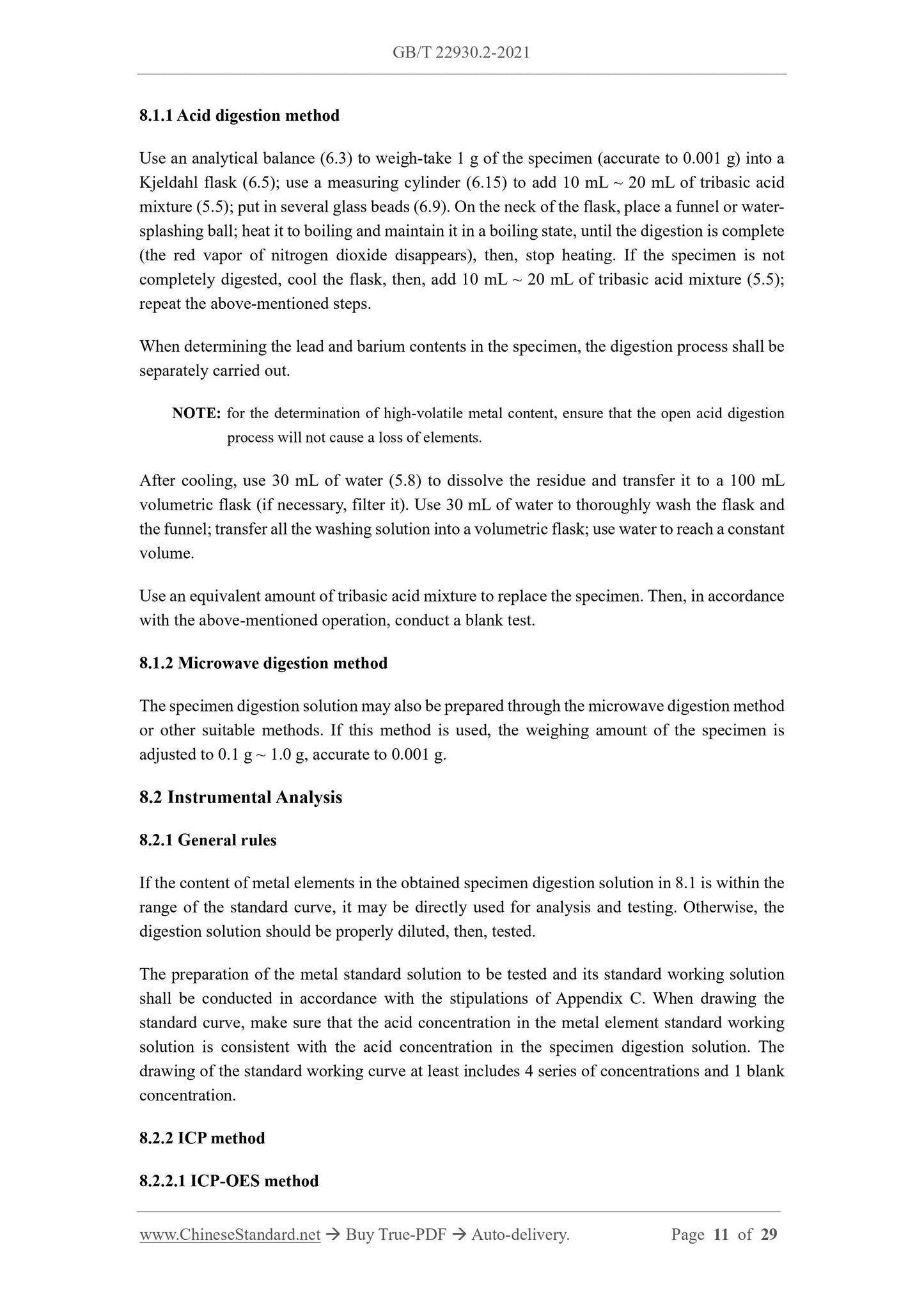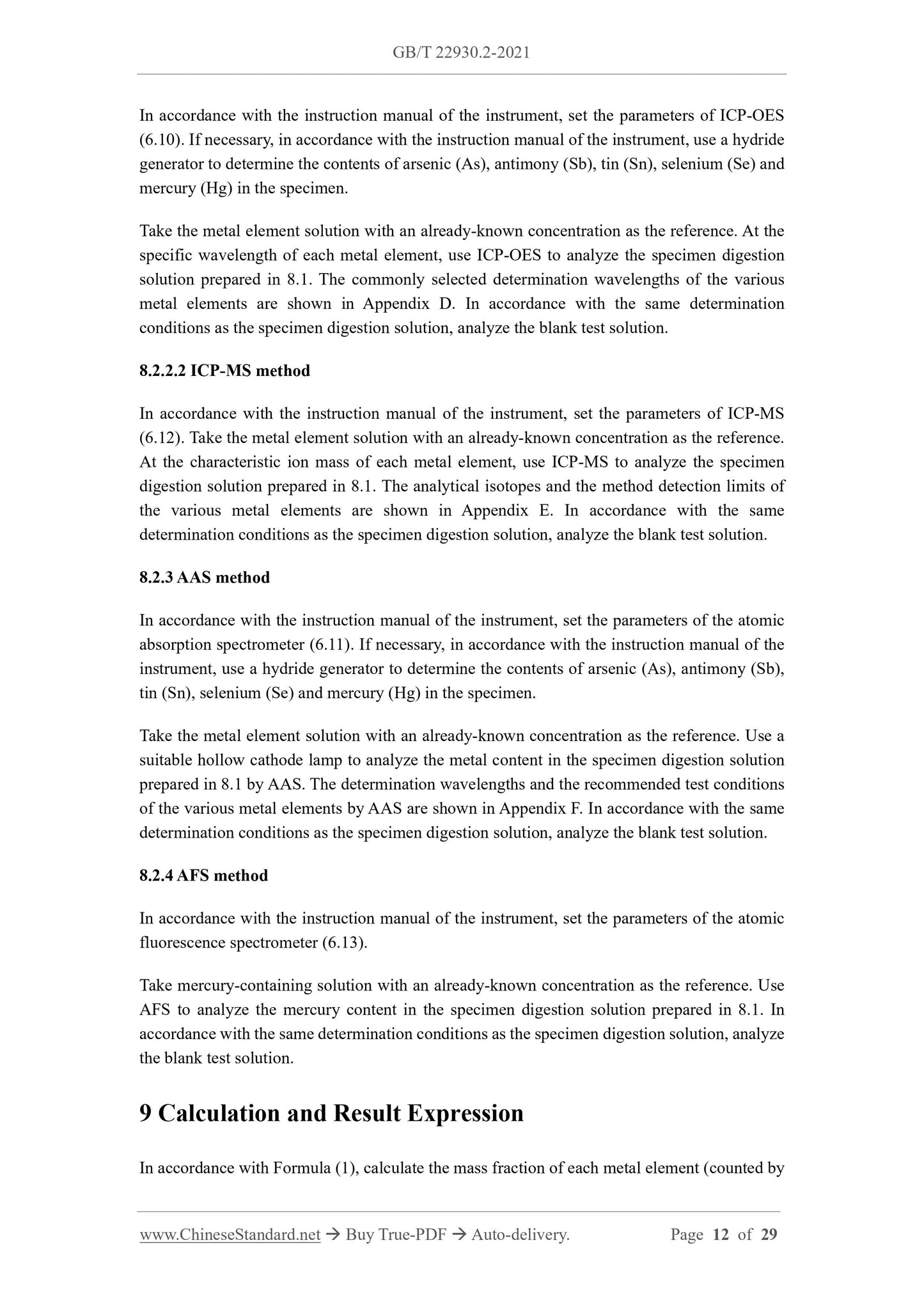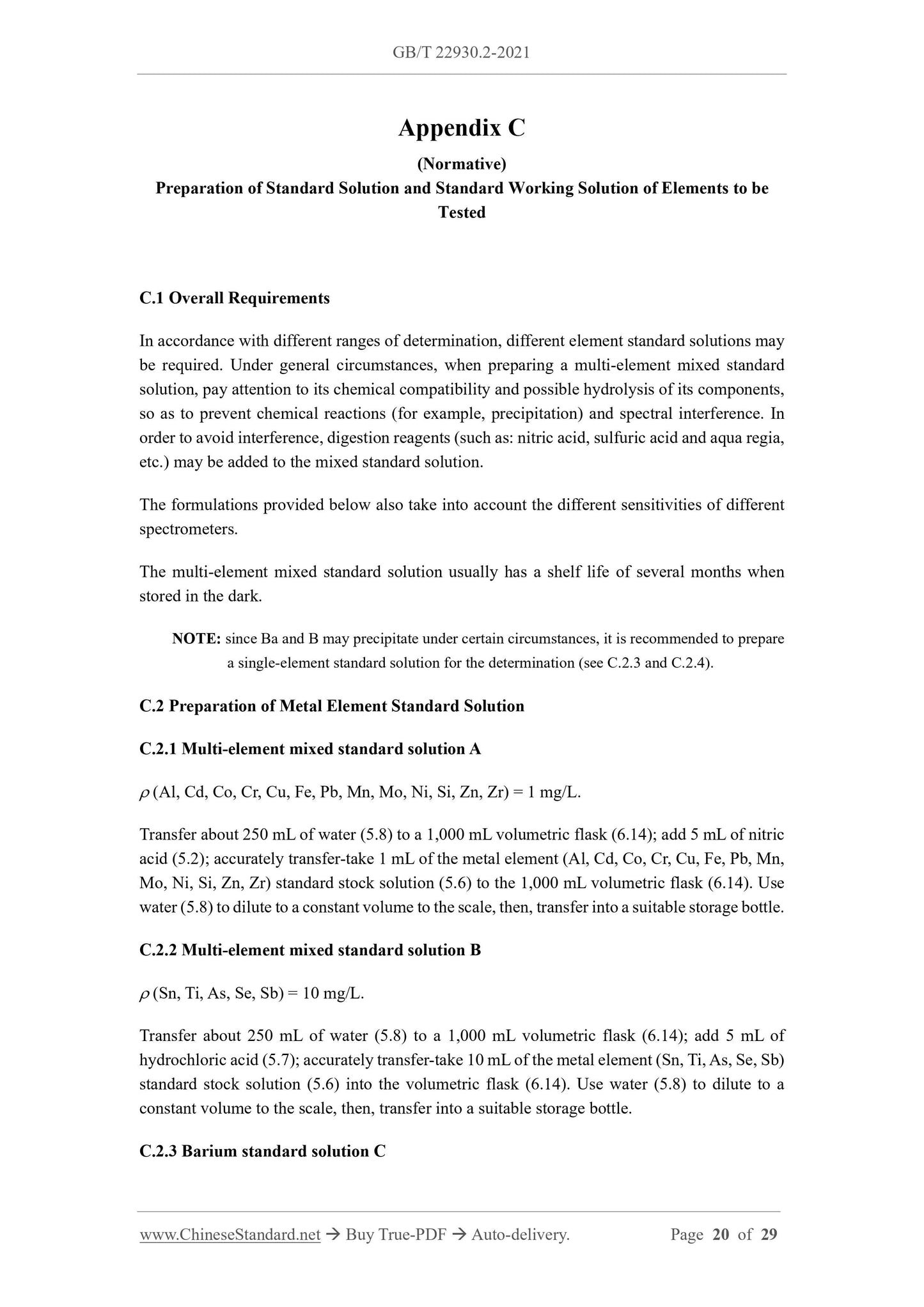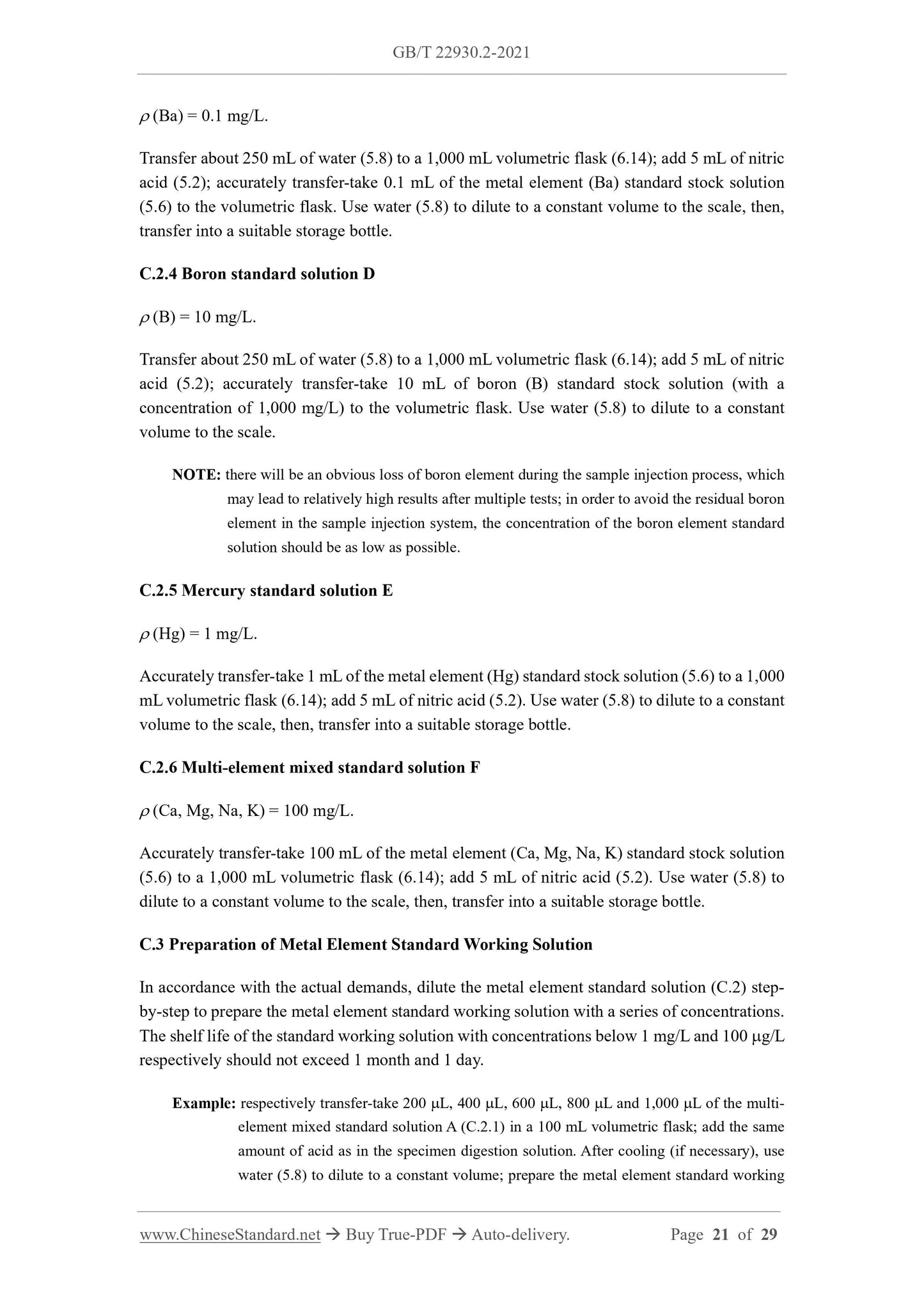1
/
of
8
PayPal, credit cards. Download editable-PDF & invoice In 1 second!
GB/T 22930.2-2021 English PDF (GB/T22930.2-2021)
GB/T 22930.2-2021 English PDF (GB/T22930.2-2021)
Regular price
$350.00 USD
Regular price
Sale price
$350.00 USD
Unit price
/
per
Shipping calculated at checkout.
Couldn't load pickup availability
Delivery: 3 seconds. Download true-PDF + Invoice.
Get QUOTATION in 1-minute: Click GB/T 22930.2-2021
Historical versions: GB/T 22930.2-2021
Preview True-PDF (Reload/Scroll if blank)
GB/T 22930.2-2021: Leather and fur -- Chemical determination of metal content -- Part 2: Total metal content
GB/T 22930.2-2021
NATIONAL STANDARD OF THE
PEOPLE’S REPUBLIC OF CHINA
ICS 59.140.30
CCS Y 46
Partially replacing GB/T 22930-2008
Leather and Fur - Chemical Determination of Metal Content
- Part 2: Total Metal Content
(ISO 17072-2:2019 Leather - Chemical Determination of Metal Content - Part 2: Total
Metal Content, MOD)
ISSUED ON: OCTOBER 11, 2021
IMPLEMENTED ON: MAY 1, 2022
Issued by: State Administration for Market Regulation;
Standardization Administration of the People’s Republic of China.
Table of Contents
Foreword ... 3
Introduction ... 6
1 Scope ... 7
2 Normative References... 7
3 Terms and Definitions ... 8
4 Principle ... 8
5 Reagents and Materials ... 8
6 Instruments and Equipment ... 9
7 Sampling and Preparation of Specimens ... 10
8 Test Procedures ... 10
9 Calculation and Result Expression ... 12
10 Test Report ... 14
Appendix A (Informative) Structural Changes of this Document Compared to ISO
17072-2:2019 ... 15
Appendix B (Informative) Technical Differences between this Document and ISO
17072-2:2019 and Causes for these Differences ... 16
Appendix C (Normative) Preparation of Standard Solution and Standard Working
Solution of Elements to be Tested ... 20
Appendix D (Informative) ICP-OES Element Determination Wavelengths and Inter-
element Interference ... 23
Appendix E (Informative) ICP-MS Analytical Isotopes and Method Detection Limits
... 25
Appendix F (Informative) AAS Element Determination Wavelengths and
Recommended Test Conditions ... 26
Appendix G (Informative) Inter-laboratory Result Comparison and Detection Limits
... 27
Bibliography... 29
Leather and Fur - Chemical Determination of Metal Content
- Part 2: Total Metal Content
WARNING: the concentrated acids used in this document are all highly corrosive and /
or oxidizing liquids. If they come into contact with flammable substances, they will
increase the possibility of combustion or explosion, and cause acute or chronic health
hazards to the human body. In addition, there are also hazards to the water body. During
the test, necessary safety measures shall be taken, and attention shall be paid to avoid the
explosive reaction that may be caused by direct contact between perchloric acid and the
specimen.
1 Scope
This document describes the test methods for the total contents of 24 metals: aluminum (Al),
arsenic (As), barium (Ba), calcium (Ca), cadmium (Cd), cobalt (Co), chromium (Cr), copper
(Cu), iron (Fe), potassium (K), magnesium (Mg), sodium (Na), lead (Pb), manganese (Mn),
molybdenum (Mo), nickel (Ni), mercury (Hg), antimony (Sb), selenium (Se), silicon (Si), tin
(Sn), titanium (Ti), zinc (Zn) and zirconium (Zr).
This document is applicable to the determination of the total contents of 24 metals in various
types of leather and fur, as well as the determination of non-metallic boron (B) content.
This document does not apply to the determination of total chromium content in chrome-tanned
leather.
NOTE: for the determination of total chromium content in chrome-tanned leather, see QB/T 2720,
QB/T 5313, QB/T 5314 or QB/T 5315.
2 Normative References
The contents of the following documents constitute indispensable clauses of this document
through the normative references in the text. In terms of references with a specified date, only
versions with a specified date are applicable to this document. In terms of references without a
specified date, the latest version (including all the modifications) is applicable to this document.
GB/T 6682 Water for Analytical Laboratory Use - Specification and Test Methods (GB/T 6682-
2008, ISO 3696:1987, MOD)
GB/T 39364 Leather - Chemical, Physical, Mechanical and Fastness Tests - Sampling Location
(GB/T 39364-2020, ISO 2418:2017, MOD)
QB/T 1267 Fur - Chemical, Physical and Mechanical and Fastness Tests - Sampling Location
(QB/T 1267-2012, ISO 2418:2002, MOD)
QB/T 1272 Leather - Chemical Tests - Preparation of Chemical Test Samples (QB/T 1272-2012,
ISO 4044:2008, MOD)
QB/T 1273 Fur - Chemical Tests - Determination of Volatile Matter (QB/T 1273-2012, ISO
4684:2005, MOD)
QB/T 1276 Fur - Chemical Tests - Determination of Matter Soluble in Carbon Tetrachloride
(QB/T 1276-2012, ISO 4048:2008, MOD)
QB/T 2716 Leather - Preparation of Chemical Test Samples (QB/T 2716-2018, ISO 4044:2008,
MOD)
QB/T 2717 Leather - Chemical Tests - Determination of Volatile (QB/T 2717-2018, ISO
4684:2005, MOD)
QB/T 2718 Leather - Chemical Tests - Determination of Matter Soluble in Dichloromethane
(QB/T 2718-2018, ISO 4048:2008, MOD)
3 Terms and Definitions
This document does not have terms or definitions that need to be defined.
4 Principle
Leather or fur specimen is completely digested by tribasic acid mixture (acid digestion method)
or microwave digestion apparatus (microwave digestion method). Use water to dissolve the
residue, then, adopt the inductively coupled plasma optical emission spectrometer (ICP-OES),
inductively coupled plasma mass spectrometer (ICP-MS), atomic absorption spectrometer
(AAS) or atomic fluorescence spectrometer (AFS) to determine the metal concentration;
calculate the total metal content in the specimen.
NOTE: this document determines the total contents of metal elements in leather and fur, not the
content of metal in a specific compound or oxidation state.
5 Reagents and Materials
5.1 Unless it is otherwise specified, the chemical reagents used for the acid digestion method
are of analytical purity, and the microwave digestion method shall use acids of superior-grade
purity. All used solutions are aqueous solutions.
5.2 Nitric acid, with a mass fraction of 60% ~ 70%.
5.3 Sulfuric acid, with a mass fraction of 98%.
8.1.1 Acid digestion method
Use an analytical balance (6.3) to weigh-take 1 g of the specimen (accurate to 0.001 g) into a
Kjeldahl flask (6.5); use a measuring cylinder (6.15) to add 10 mL ~ 20 mL of tribasic acid
mixture (5.5); put in several glass beads (6.9). On the neck of the flask, place a funnel or water-
splashing ball; heat it to boiling and maintain it in a boiling state, until the digestion is complete
(the red vapor of nitrogen dioxide disappears), then, stop heating. If the specimen is not
completely digested, cool the flask, then, add 10 mL ~ 20 mL of tribasic acid mixture (5.5);
repeat the above-mentioned steps.
When determining the lead and barium contents in the specimen, the digestion process shall be
separately carried out.
NOTE: for the determination of high-volatile metal content, ensure that the open acid digestion
process will not cause a loss of elements.
After cooling, use 30 mL of water (5.8) to dissolve the residue and transfer it to a 100 mL
volumetric flask (if necessary, filter it). Use 30 mL of water to thoroughly wash the flask and
the funnel; transfer all the washing solution into a volumetric flask; use water to reach a constant
volume.
Use an equivalent amount of tribasic acid mixture to replace the specimen. Then, in accordance
with the above-mentioned operation, conduct a blank test.
8.1.2 Microwave digestion method
The specimen digestion solution may also be prepared through the microwave digestion method
or other suitable methods. If this method is used, the weighing amount of the specimen is
adjusted to 0.1 g ~ 1.0 g, accurate to 0.001 g.
8.2 Instrumental Analysis
8.2.1 General rules
If the content of metal elements in the obtained specimen digestion s...
Get QUOTATION in 1-minute: Click GB/T 22930.2-2021
Historical versions: GB/T 22930.2-2021
Preview True-PDF (Reload/Scroll if blank)
GB/T 22930.2-2021: Leather and fur -- Chemical determination of metal content -- Part 2: Total metal content
GB/T 22930.2-2021
NATIONAL STANDARD OF THE
PEOPLE’S REPUBLIC OF CHINA
ICS 59.140.30
CCS Y 46
Partially replacing GB/T 22930-2008
Leather and Fur - Chemical Determination of Metal Content
- Part 2: Total Metal Content
(ISO 17072-2:2019 Leather - Chemical Determination of Metal Content - Part 2: Total
Metal Content, MOD)
ISSUED ON: OCTOBER 11, 2021
IMPLEMENTED ON: MAY 1, 2022
Issued by: State Administration for Market Regulation;
Standardization Administration of the People’s Republic of China.
Table of Contents
Foreword ... 3
Introduction ... 6
1 Scope ... 7
2 Normative References... 7
3 Terms and Definitions ... 8
4 Principle ... 8
5 Reagents and Materials ... 8
6 Instruments and Equipment ... 9
7 Sampling and Preparation of Specimens ... 10
8 Test Procedures ... 10
9 Calculation and Result Expression ... 12
10 Test Report ... 14
Appendix A (Informative) Structural Changes of this Document Compared to ISO
17072-2:2019 ... 15
Appendix B (Informative) Technical Differences between this Document and ISO
17072-2:2019 and Causes for these Differences ... 16
Appendix C (Normative) Preparation of Standard Solution and Standard Working
Solution of Elements to be Tested ... 20
Appendix D (Informative) ICP-OES Element Determination Wavelengths and Inter-
element Interference ... 23
Appendix E (Informative) ICP-MS Analytical Isotopes and Method Detection Limits
... 25
Appendix F (Informative) AAS Element Determination Wavelengths and
Recommended Test Conditions ... 26
Appendix G (Informative) Inter-laboratory Result Comparison and Detection Limits
... 27
Bibliography... 29
Leather and Fur - Chemical Determination of Metal Content
- Part 2: Total Metal Content
WARNING: the concentrated acids used in this document are all highly corrosive and /
or oxidizing liquids. If they come into contact with flammable substances, they will
increase the possibility of combustion or explosion, and cause acute or chronic health
hazards to the human body. In addition, there are also hazards to the water body. During
the test, necessary safety measures shall be taken, and attention shall be paid to avoid the
explosive reaction that may be caused by direct contact between perchloric acid and the
specimen.
1 Scope
This document describes the test methods for the total contents of 24 metals: aluminum (Al),
arsenic (As), barium (Ba), calcium (Ca), cadmium (Cd), cobalt (Co), chromium (Cr), copper
(Cu), iron (Fe), potassium (K), magnesium (Mg), sodium (Na), lead (Pb), manganese (Mn),
molybdenum (Mo), nickel (Ni), mercury (Hg), antimony (Sb), selenium (Se), silicon (Si), tin
(Sn), titanium (Ti), zinc (Zn) and zirconium (Zr).
This document is applicable to the determination of the total contents of 24 metals in various
types of leather and fur, as well as the determination of non-metallic boron (B) content.
This document does not apply to the determination of total chromium content in chrome-tanned
leather.
NOTE: for the determination of total chromium content in chrome-tanned leather, see QB/T 2720,
QB/T 5313, QB/T 5314 or QB/T 5315.
2 Normative References
The contents of the following documents constitute indispensable clauses of this document
through the normative references in the text. In terms of references with a specified date, only
versions with a specified date are applicable to this document. In terms of references without a
specified date, the latest version (including all the modifications) is applicable to this document.
GB/T 6682 Water for Analytical Laboratory Use - Specification and Test Methods (GB/T 6682-
2008, ISO 3696:1987, MOD)
GB/T 39364 Leather - Chemical, Physical, Mechanical and Fastness Tests - Sampling Location
(GB/T 39364-2020, ISO 2418:2017, MOD)
QB/T 1267 Fur - Chemical, Physical and Mechanical and Fastness Tests - Sampling Location
(QB/T 1267-2012, ISO 2418:2002, MOD)
QB/T 1272 Leather - Chemical Tests - Preparation of Chemical Test Samples (QB/T 1272-2012,
ISO 4044:2008, MOD)
QB/T 1273 Fur - Chemical Tests - Determination of Volatile Matter (QB/T 1273-2012, ISO
4684:2005, MOD)
QB/T 1276 Fur - Chemical Tests - Determination of Matter Soluble in Carbon Tetrachloride
(QB/T 1276-2012, ISO 4048:2008, MOD)
QB/T 2716 Leather - Preparation of Chemical Test Samples (QB/T 2716-2018, ISO 4044:2008,
MOD)
QB/T 2717 Leather - Chemical Tests - Determination of Volatile (QB/T 2717-2018, ISO
4684:2005, MOD)
QB/T 2718 Leather - Chemical Tests - Determination of Matter Soluble in Dichloromethane
(QB/T 2718-2018, ISO 4048:2008, MOD)
3 Terms and Definitions
This document does not have terms or definitions that need to be defined.
4 Principle
Leather or fur specimen is completely digested by tribasic acid mixture (acid digestion method)
or microwave digestion apparatus (microwave digestion method). Use water to dissolve the
residue, then, adopt the inductively coupled plasma optical emission spectrometer (ICP-OES),
inductively coupled plasma mass spectrometer (ICP-MS), atomic absorption spectrometer
(AAS) or atomic fluorescence spectrometer (AFS) to determine the metal concentration;
calculate the total metal content in the specimen.
NOTE: this document determines the total contents of metal elements in leather and fur, not the
content of metal in a specific compound or oxidation state.
5 Reagents and Materials
5.1 Unless it is otherwise specified, the chemical reagents used for the acid digestion method
are of analytical purity, and the microwave digestion method shall use acids of superior-grade
purity. All used solutions are aqueous solutions.
5.2 Nitric acid, with a mass fraction of 60% ~ 70%.
5.3 Sulfuric acid, with a mass fraction of 98%.
8.1.1 Acid digestion method
Use an analytical balance (6.3) to weigh-take 1 g of the specimen (accurate to 0.001 g) into a
Kjeldahl flask (6.5); use a measuring cylinder (6.15) to add 10 mL ~ 20 mL of tribasic acid
mixture (5.5); put in several glass beads (6.9). On the neck of the flask, place a funnel or water-
splashing ball; heat it to boiling and maintain it in a boiling state, until the digestion is complete
(the red vapor of nitrogen dioxide disappears), then, stop heating. If the specimen is not
completely digested, cool the flask, then, add 10 mL ~ 20 mL of tribasic acid mixture (5.5);
repeat the above-mentioned steps.
When determining the lead and barium contents in the specimen, the digestion process shall be
separately carried out.
NOTE: for the determination of high-volatile metal content, ensure that the open acid digestion
process will not cause a loss of elements.
After cooling, use 30 mL of water (5.8) to dissolve the residue and transfer it to a 100 mL
volumetric flask (if necessary, filter it). Use 30 mL of water to thoroughly wash the flask and
the funnel; transfer all the washing solution into a volumetric flask; use water to reach a constant
volume.
Use an equivalent amount of tribasic acid mixture to replace the specimen. Then, in accordance
with the above-mentioned operation, conduct a blank test.
8.1.2 Microwave digestion method
The specimen digestion solution may also be prepared through the microwave digestion method
or other suitable methods. If this method is used, the weighing amount of the specimen is
adjusted to 0.1 g ~ 1.0 g, accurate to 0.001 g.
8.2 Instrumental Analysis
8.2.1 General rules
If the content of metal elements in the obtained specimen digestion s...
Share
